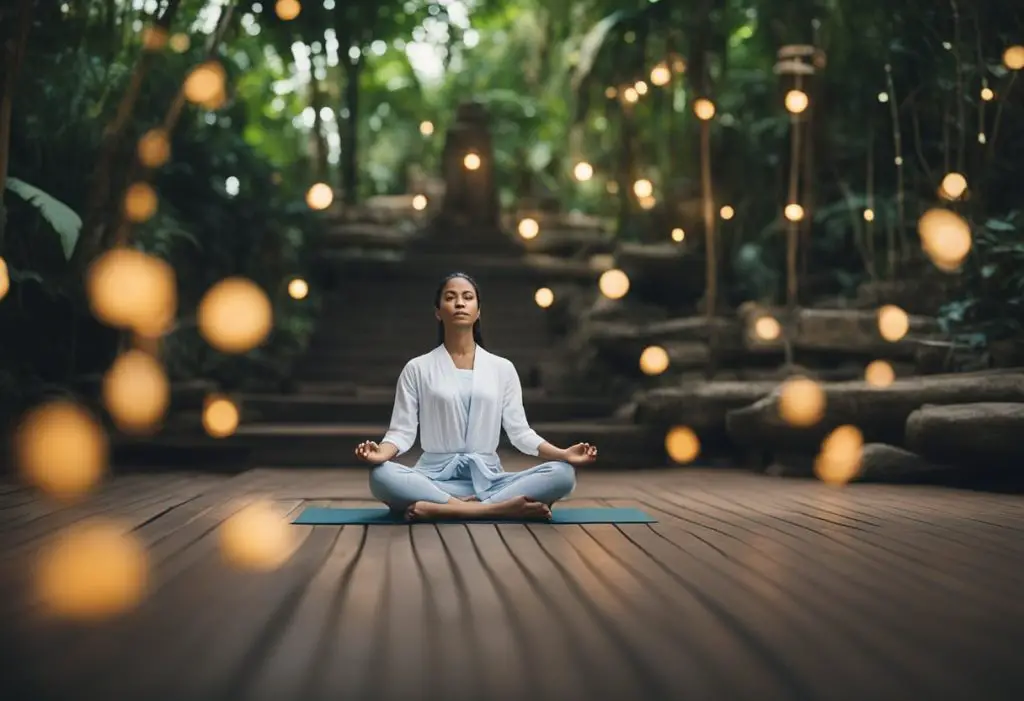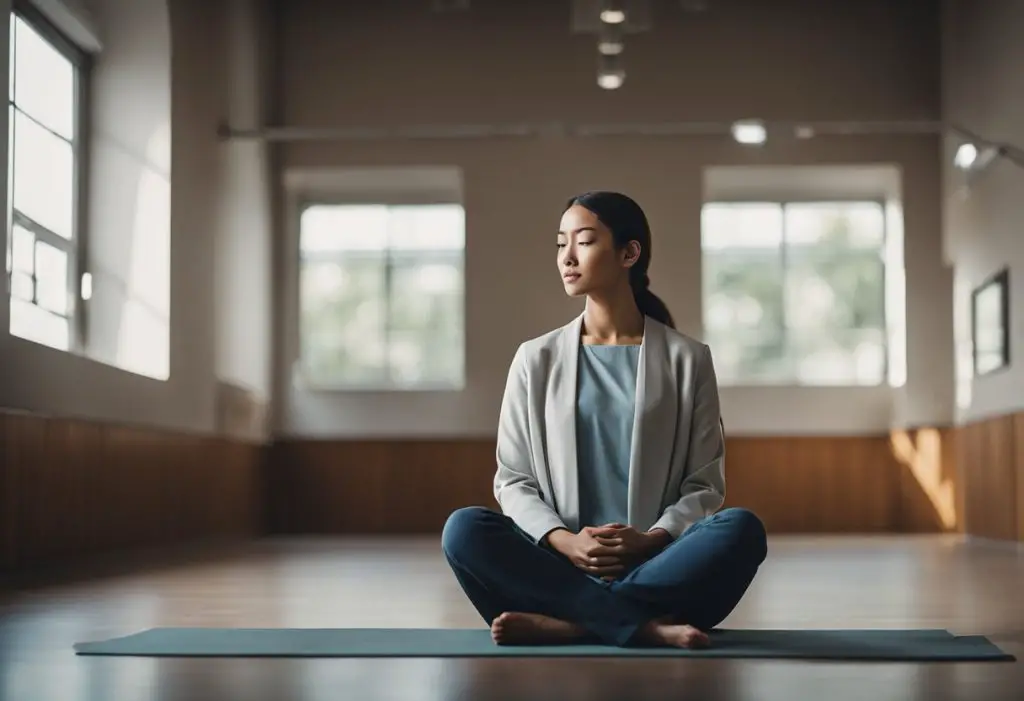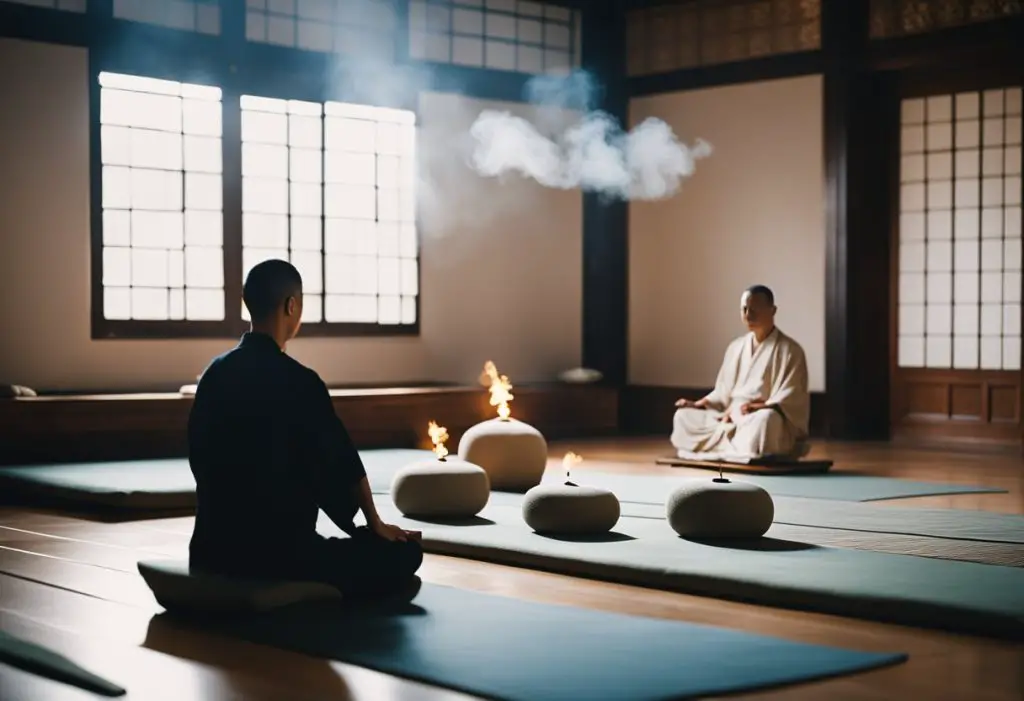Zazen, the meditative discipline central to Zen Buddhism, is a practice deeply rooted in the pursuit of clarity and self-awareness. It is often referred to simply as “sitting,” but this understated term belies the depth of concentration and discipline required. The technique emphasizes stillness and the act of being present within one’s own mind and body, distinguishing it from other forms of meditation that may focus on visualizations or mantras.

This form of Zen meditation embraces simplicity and mindfulness. Practitioners sit in a specific posture, pay careful attention to their breathing, and observe the thoughts and sensations that arise without attachment. The ultimate goal of Zazen is to find insight into the nature of existence, leading to personal enlightenment but starting with the cultivation of a calm, non-reactive mind.
Engaging in Zazen can be a powerful experience, providing benefits such as increased focus, reduced stress, and a greater sense of peace. This tranquil practice is not meant to provide a quick fix or fleeting escape from life’s challenges, but rather it offers a path to long-term spiritual and emotional balance. By learning and applying the principles of Zazen, individuals seek to develop a mindful approach to every aspect of their lives, cultivating presence and serenity over time.
Understanding Zazen
Zazen is a meditation practice at the heart of Zen Buddhism, offering a pathway to insight and tranquility. It prioritizes mental discipline, mindfulness, and the pursuit of enlightenment.
Historical Background
Zen Buddhism traces its origins to the teachings of the Buddha, where meditation is a critical element in seeking enlightenment. Zazen, in particular, emerged in China during the Tang dynasty, becoming central to Zen practice. It was later transmitted to Japan, where it flourished and continues to play a pivotal role in daily Zen training.
Benefits of Zazen
Practitioners of Zazen report a multitude of mental health benefits, such as reduced stress and anxiety levels. This meditation practice fosters deep concentration, contributing to enhanced mindfulness and greater emotional stability.
- Improved Focus: Regular Zazen helps sharpen concentration.
- Stress Reduction: Engaging in Zazen can alleviate stress.
- Mindfulness: Zazen cultivates an awareness of the present moment.
Philosophical Concepts
In Zazen, adherents sit and observe the movements of their own minds. At its core, it teaches that enlightenment is the natural state, accessible through disciplined meditation. Zazen strips away complexities, returning to simplicity and direct experience.
- Shikantaza: Also called “just sitting,” it is a form without a goal beyond the act itself.
- Non-attachment: A profound aspect of Zazen, promoting the release from thoughts and feelings.
Setting Up for Zazen
Before embarking on the practice of Zazen, or seated meditation, it is essential to establish a conducive environment and proper equipment. The following guidelines will assist practitioners in setting up a space that is both physically comfortable and mentally tranquil, laying the groundwork for a fruitful Zazen session.
Choosing a Quiet Place
One should locate a space that is free from noise and distraction. This quiet place facilitates the deep concentration and mindfulness at the heart of Zazen practice. It can be indoors, like a dedicated room or a quiet corner, or outdoors in a serene setting, as long as it is a place where one is unlikely to be disturbed.
Ideal locations include:
- A spare room with minimal traffic
- A peaceful garden area
- A secluded outdoor space away from busy streets
Proper Seating Arrangements
The practitioner’s posture is crucial. They must sit in a way that allows for a straight and stable spine while maintaining comfort throughout the session. Common positions include the lotus position and a simple cross-legged position. Beginners may start with a half-lotus or a comfortable sitting style that permits attentiveness and physical stability.
Key posture elements are:
- A straight back, not rigid or slouched
- Hands placed gently in the lap or on the thighs
- Chin slightly tucked in to align the neck with the spine
Zafu and Zabuton Use
Using a zafu, a round cushion, and a zabuton, a rectangular mat, helps in maintaining proper posture while providing comfort during the seated meditation. The zafu raises the hips, allowing the knees to touch the ground, which forms a tripod base that increases stability. The zabuton cushions the knees and legs from the hard floor.
Proper arrangement:
- Place the zabuton on the floor.
- Set the zafu on top of the zabuton.
- Sit on the zafu, positioning oneself so that the knees can rest comfortably on the zabuton.
In addition to the physical setup, an altarpiece can be placed in front of the meditation spot to serve as a focal point. This could be a simple statue, a painting, or any item that holds significance to the practitioner and aids in centering their thoughts.
Zazen Posture
The correct posture is essential in Zazen meditation for maintaining focus and balance. One’s physical alignment, hand positions, and sitting stance contribute to a stable and comfortable meditation experience.
Sitting Positions
The traditional Lotus Position (Full Lotus) with each foot placed on the opposite thigh is ideal but can be difficult for beginners. The Half-Lotus is a less strenuous variant with one foot on the opposite thigh and the other foot underneath the opposite knee. For those needing a gentler option, the Burmese Position positions both feet on the floor, with legs crossed so that both knees touch the ground. In a chair, one can sit with feet flat on the floor, back straight without support.
Hand Positions and Mudras
Mudras, or hand positions, are central in Zazen to maintain the energy flow and concentration. The most common is the Cosmic Mudra (Dhyana Mudra), where one places their right hand over their left, palms up, with the tips of the thumbs touching gently, creating a subtle oval. This mudra rests comfortably on the hara, the area around the stomach considered the center of spiritual energy.
Physical Alignment
Proper physical alignment focuses on a straight but relaxed spine, offering a sense of groundedness. One’s head should be tilted slightly downward, chin in, with the gaze lowered at a 45-degree angle to reduce eye strain and mental distraction. Shoulders are rolled back gently and the chest open, while one breathes naturally, not forcedly, through the nose, allowing the abdomen to rise and fall. Balance and comfort are achieved through a pose that’s neither rigid nor slouched, finding a natural equilibrium that supports extended periods of Zazen practice.
Commencing Zazen
In beginning Zazen meditation, one must establish proper breathing, maintain focus, and manage distractions to ensure a successful practice.
Breathing Techniques
The foundation of Zazen is rooted in the breath. The meditator should sit comfortably in a quiet place and take several deep, slow breaths to settle into the meditation session. Breathing should be natural and done through the nose, involving deep inhalations that fill the abdomen and exhalations that completely release the air. They should count each breath, from one to ten, then repeat the cycle, to help maintain awareness and foster concentration.
Focusing the Mind
To focus the mind, practitioners are encouraged to direct their attention to the present moment. This involves being aware of the breath while letting go of wandering thoughts. One can focus on a single point, such as the sensation of breathing at the tip of the nose or the rise and fall of the abdomen, to cultivate focus and remain present during the meditation.
Handling Distractions
Distractions are inevitable. Meditators should acknowledge distractions without judgement and return their focus to the breath. They may note the distraction—be it a sound, a thought, or a sensation—and gently guide their awareness back to their breathing. This practice of returning to the breath builds concentration and strengthens the ability to stay grounded in the present moment.
Deepening Zazen Practice
To deepen one’s Zazen practice, regularity and incorporating core Zen teachings are fundamental. Diligence in these areas cultivates joriki, the inner strength that arises from meditation.
Maintaining Regular Practice
One should establish a consistent schedule, as regularity is paramount in deepening Zazen meditation. It is suggested that a practitioner chooses a specific time and place each day for their practice, which nourishes patience and discipline. A table for a proposed weekly schedule could look like this:
| Day | Time | Duration |
|---|---|---|
| Monday | 6:30 am | 30 minutes |
| Tuesday | 6:30 am | 30 minutes |
| Wednesday | 6:30 am | 30 minutes |
| Thursday | 6:30 am | 30 minutes |
| Friday | 6:30 am | 30 minutes |
| Saturday | 8:00 am | 45 minutes |
| Sunday | 8:00 am | 45 minutes |
By adhering to such a schedule, a practitioner can engrain their practice into daily life, allowing for gradual progress and a deeper exploration of the meditative state.
Incorporating Zen Teachings
Integrating the core teachings of Zen through studying with a qualified teacher or engaging with traditional koans can enhance one’s practice. A teacher provides personalized guidance and insights that resonate throughout a practitioner’s journey. Additionally, contemplating a koan or repeating a mantra can focus the mind and promote deeper understanding.
- Teacher Encounter:
- Seek guidance on posture, breathing, and mindset.
- Discuss personal challenges and milestones.
- Koans and Mantras:
- Choose a koan or mantra to internalize Zen teachings.
- Reflect on this during each practice session.
Through consistency in practice and the thoughtful application of Zen teachings, a practitioner embarks on a path to profound self-awareness and mindfulness.
Zazen and Daily Life
Incorporating Zazen into daily life enhances mindfulness, fosters compassion, and aids in releasing attachments. These practices are not confined to the cushion but extend to every moment of one’s routine.
Applying Mindfulness
Mindfulness, the core of Zazen, is the practice of being present in each moment. To apply this in daily life, one might start by focusing on the breath while performing mundane tasks, such as:
- Breathing: Pay attention to the inhalation and exhalation during activities like washing dishes or walking.
- Eating: Chew food slowly, savoring each bite and being aware of the textures and flavors.
This practice allows individuals to remain grounded in the present, reducing stress and enhancing focus.
Cultivating Compassion
Through compassion, an individual can relate to others with kindness and understanding. Zazen encourages seeing oneself in others, which can be expressed in daily life through:
| Actions | Description |
|---|---|
| Listening Actively | Giving full attention in conversations, showing genuine interest in others’ experiences. |
| Offering Assistance | Helping without expectation of return, whether it’s holding a door open or volunteering. |
Compassion becomes a natural response and promotes harmonious relationships.
Letting Go of Attachments
Attachment to material things, opinions, or outcomes often causes suffering. In Zazen, letting go is practiced regularly, and in everyday life, this may translate into:
- Material Perspective: Treating possessions as temporary, not as extensions of one’s self.
- Flexibility: Accepting changing situations without resistance, adapting with calmness.
By reducing attachments, one finds freedom and tranquility in the flux of life’s circumstances.
Zazen in Relation to Other Practices

Zazen meditation, a form of seated meditation, is deeply intertwined with various practices in both martial arts and different schools of Buddhism. Its integration with other forms of meditation is vast and can enhance the practitioner’s spiritual and physical discipline.
Zazen and Martial Arts
Martial arts, particularly in Japanese traditions, often incorporate Zazen as a method to train the mind alongside the body. Practitioners believe that the mental focus and mindfulness learned through Zazen can significantly enhance martial abilities.
- Bompu: Sometimes utilized within martial arts, this secular practice of Zazen focuses on improving physical and mental well-being without religious or spiritual aspirations.
- Gedo: While not directly aimed at enlightenment, Gedo, or “outside way,” practices including Zazen can still be instrumental in martial arts training, aiding in the cultivation of discipline and concentration.
Zazen in Different Schools
Different schools of Buddhism embrace Zazen with varying philosophies and methods.
- Shojo: This practice aims for personal enlightenment and considers Zazen as a fundamental activity.
- Daijo: Here, Zazen is seen as essential for the great vehicle of enlightenment, emphasizing the unity of practice and insight.
- Saijojo: Often regarded as the highest form of Zazen, it transcends the duality of practice and enlightenment, representing the non-dual nature of Zen.
Integrating Zazen with Other Forms of Meditation
Practitioners of Zazen may also incorporate techniques from other meditation forms to enrich their practice.
- Mindfulness Meditation: Similar to Zazen’s focus on the present moment, mindfulness can be used in conjunction with Zazen to deepen awareness.
- Concentration Meditation: Techniques that develop deep concentration can be integrated with Zazen to strengthen the ability to remain seated in calmness for extended periods.
Challenges and Solutions
In the practice of Zazen meditation, adherents often face certain challenges that can impede their progress. This section provides strategies for overcoming common obstacles related to drowsiness, physical discomfort, and mental resistance, in order to enhance meditation practice.
Overcoming Drowsiness
Drowsiness during Zazen can be a significant barrier to maintaining focus and alertness. Practitioners can:
- Adjust their meditation schedule to times when they feel most awake, avoiding periods after heavy meals or during their usual time for sleep.
- Enhance their environment’s stimuli, such as brightening the room or incorporating a cooling breeze.
| Strategies | How it helps |
|---|---|
| Sitting upright | Promotes alertness and reduces the likelihood of dozing off. |
| Opening the eyes | Sustains visual awareness which can help fend off sleepiness. |
Managing Physical Discomfort
Physical discomfort during Zazen meditation can arise from prolonged stillness. To mitigate this, individuals should:
- Invest in a comfortable meditation cushion or chair that supports their posture.
- Introduce gentle stretching exercises or yoga before sitting to relax muscles and enhance blood flow.
| Issue | Solution |
|---|---|
| Leg numbness | Adjust position gradually to restore circulation. |
| Back pain | Maintain a natural spine curve; do not overarch. |
Addressing Mental Resistance
Mental resistance to meditation can manifest as stress, anxiety, or impatience, and can also be reinforced by addiction patterns or mental health conditions. To confront this challenge:
- They should set realistic goals for their practice, acknowledging that patience is essential for progress.
- Utilize mindfulness techniques to observe their thoughts without judgment, thereby reducing the emotional weight of stress and anxiety.
| Mental Barrier | Strategy |
|---|---|
| Stress | Focus on the breath to anchor the mind in the present. |
| Anxiety | Identify and observe anxious thoughts as external to the self. |
Transitioning Out of Zazen

Transitioning out of Zazen meditation is a deliberate process that brings the mindfulness and calmness of the session into one’s daily life. It requires awareness of emotions and a gentle re-engagement with the surroundings.
Closing the Meditation Session
When one is ready to end their meditation session, they should take a few deep breaths and savor the last moments of stillness. It’s important to slowly become aware of the physical body and the space around them. Here is a simple procedure:
- Take three deep breaths, following the inhalation and exhalation attentively.
- Gently wiggle fingers and toes to reconnect with the physical sensations.
- Slowly open the eyes, lower the gaze, and give oneself a moment to adjust to the light and the environment.
- Place palms together in gassho (a gesture of respect) and bow slightly to acknowledge the meditation practice.
- Rise from the seated position gradually, to maintain the serenity and not to startle the body.
Practical Post-Meditation Tips
After the meditation session, individuals should maintain the mindfulness cultivated during Zazen as they transition back into daily life.
- Rehydrate: Drink a glass of water to refresh the body.
- Stretch Gently: Perform some light stretches to awaken the body fully.
- Mindful Actions: Engage in actions mindfully, whether it’s walking or preparing a meal, to extend the state of Zazen into daily routines.
- Observe Emotions: Notice any emotions that arise post-meditation and acknowledge them without judgment, reinforcing emotional awareness.
By taking these steps, one ensures that they carry the calmness and clarity from their Zazen practice into the rest of their day, benefiting both their mind and emotional well-being.
Advanced Techniques and Concepts
In this section, practitioners seeking a deeper understanding and mastery of Zazen will discover the complexities of proficiency stages and the use of tools like koans and mantras to enhance their meditative journey.
Stages of Zazen Proficiency
In Zen Buddhism, practitioners often progress through various stages of enlightenment as they refine their Zazen meditation technique. The saijojo stage represents the highest level of proficiency, characterized by a profound unity with one’s true nature. The following table outlines the general progression through these stages:
| Stage | Description |
|---|---|
| Shoshin | The beginner’s mind, open and eager to learn. |
| Zazen | Regular practice of sitting meditation, developing focus. |
| Kensho | An initial insight into one’s true nature, often fleeting. |
| Daijo | A deeper experience of enlightenment, more substantial than kensho. |
| Saijojo | Complete and effortless unity with true nature, the goal of Zazen. |
Each stage requires diligent practice, self-reflection, and commitment to the principles of Zen.
Exploring Koans and Mantras
A koan is a paradoxical anecdote or riddle used in Zen Buddhism to demonstrate the inadequacy of logical reasoning and provoke enlightenment. Engaging with koans can be a powerful technique for advanced Zazen meditation. Practitioners may spend months or even years contemplating a single koan to reach a deeper understanding of their true nature.
On the other hand, a mantra is a phrase or word repeated during meditation to aid concentration and bring about transformative states of consciousness. Mantras serve as focal points, helping practitioners to maintain attention and delve into the meditative experience.
To effectively use these advanced tools, one should approach them with focus and reverence, as they are integral to deepening one’s meditation practice and advancing through the stages of Zazen proficiency.
Zazen Etiquette and Community

Engaging in Zazen within a community setting involves observing proper conduct and nurturing relationships. This ensures a harmonious practice environment that respects both the tradition and fellow practitioners.
Behavior in a Zendo
The zendo, or meditation hall, is a sacred space where mindfulness and silence are paramount. Practitioners should:
- Enter quietly: They remove shoes and move softly, acknowledging the space with a bow before finding their spot.
- Maintain silence: During meditation and kinhin (walking meditation), silence is observed to cultivate concentration and mutual respect.
Participating in Sesshins and Retreats
Sesshins are intensive periods of meditation that can last several days, offering deep dives into practice. At retreats, one should:
- Adhere to the schedule: Full participation in the daily routine, from zazen to community work, displays commitment.
- Respect the guidelines: Observing silence and following instructions during meditation, work, and meals supports the collective focus.
Building Sangha Relationships
Sangha refers to the community of practitioners. Strong sangha relationships are fostered through:
- Shared practice: Regular attendance and participation in group meditations and discussions create bonds.
- Mutual support: Offering help and engaging in community activities, such as group meals and maintenance of the zendo, strengthens the sense of belonging.
